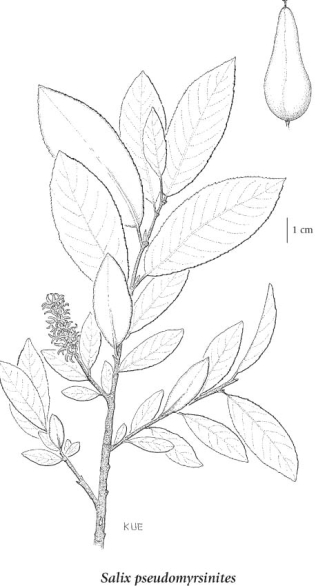Salix pseudomyrsinites Andersson
tall blueberry willow (firmleaf willow)
Salicaceae (Willow family)
Introduction to Vascular Plants
tall blueberry willow (firmleaf willow)
Salicaceae (Willow family)
Introduction to Vascular Plants
Species Information
General:
Dioecious shrubs, 1-7 m tall, not colonial; branches erect, flexible at base; twigs yellow- to red-brown, sparsely to densely hairy.
Leaves:
Alternate, simple, oblong to elliptic, lance- or egg-shaped, 3-11 cm long, 1-5 cm wide, lower surface not glaucous, sparsely long soft-hairy or becoming smooth, hairs white and rust-coloured; upper surface shiny, smooth or midrib moderately hairy, margins toothed or entire, bases wedge-shaped to rounded or heart-shaped, tips pointed to rounded; leaf stalks without glandular dots at top; stipules leaflike or rudimentary.
Flowers:
Unisexual, lacking sepals and petals, borne in catkins which flower as leaves emerge, the catkins stout, on leafy twigs; floral bracts dark to pale, smooth or hairy, hairs wavy or curly; stamens 2; ovaries 1, smooth; styles 0.4-1.6 mm long.
Fruits:
Capsules which split open to release the seeds, each of which is surrounded by a tuft of hairs; stalks 0.8-1.4 mm long.
Notes:
This tetraploid taxon is specifically distinct from the related diploid, S. myrtillifolia. It may be distinguished by its tall growth form, usually hairy leaves, longer styles and its occurrence in upland forests and the shores of lakes and rivers. For a comparison with S. myrtillifolia and S. boothii see Table 2, page 60 of the Illustrated Flora of British Columbia.
Illustration

If more than one illustration is available for a species (e.g., separate illustrations were provided for two subspecies) then links to the separate images will be provided below. Note that individual subspecies or varietal illustrations are not always available.
Illustration Source: The Illustrated Flora of British Columbia
Ecology
Ecological Framework for Salix pseudomyrsinites
The table below shows the species-specific information calculated from
original data (BEC database) provided by the BC Ministry of Forests and Range.
(Updated August, 2013)
The table below shows the species-specific information calculated from
original data (BEC database) provided by the BC Ministry of Forests and Range.
(Updated August, 2013)
| Site Information |
Value / Class |
||
|
Avg |
Min |
Max |
|
| Elevation
(metres) |
839 | 390 | 1645 |
| Slope
Gradient (%) |
0 | 0 | 10 |
|
Aspect (degrees) |
10 | 20 | 360 |
| Soil
Moisture Regime (SMR) [0 - very xeric; 4 - mesic; 8 - hydric] |
6 | 4 | 7 |
| Modal
Nutrient Regime
Class |
C | ||
| #
of field plots species was recorded in: |
32 | ||
| Modal
BEC Zone Class |
BWBS | ||
|
All BEC Zones (# of stations/zone) species was recorded in |
BWBS(19), ESSF(8), ICH(1), MS(3), SBS(1) | ||
|
Source:
Klinkenberg 2013
|
|||
Habitat and Range
Wet to moist lakeshores, rivers, thickets, open forests and muskeg (rarely) in the montane zone; infrequent in BC east of the Coast-Cascade Mountains; N to AK, YT and NT and E to ON.Status Information
Synonyms
Synonyms and Alternate Names:
Salix myrtillifolia var. cordata (Andersson) Dorn
Salix myrtillifolia var. pseudomyrsinites (Andersson) C.R. Ball ex HultΘn
Salix novae-angliae auct. non Andersson
Salix novae-angliae var. pseudomyrsinites (Anderss.) Anderss.
Salix pseudocordata var. cordata (Anderss.) Ball